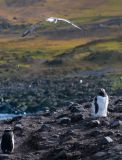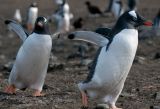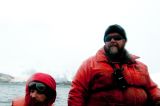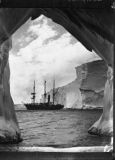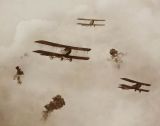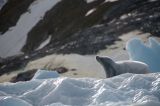
-CIA- World Factbook
-Cool Antarctica
-Discovering Antarctica
-FrankHurley.org
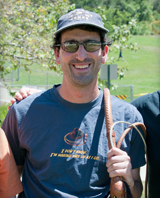
Laird's Bio
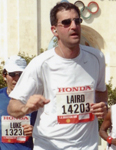
Follow Laird at
RunLairdRun.com

Support One of
Laird's Charities
Chapter 16 | Chapter 17 | Chapter 18

I cannot imagine going to a place like Antarctic and not trying to capture the magic in images. Despite going to film school, I never really developed a love of shooting video. I spoke to one of my friends the other day about this, and she said something that resonated. As film student grads, we feel a responsibility of shooting footage we can then edit. We want to set up the shots and then come home and spend hours in iMovie. To be honest, that seems like too much work and reduces the magic to mundane drudgery.
Plus for me, composition has always attracted me more than anything else. This fortunate photograph gives an example. Is this penguin really looking at that bird? I would like to think so. I love the diagonal aspect of the shot - it's almost a triangle with the smaller penguin in the bottom left completing the third vertex.
When I approach shooting, first and foremost I try to position myself at the level of the subject. I shoot a lot of pictures of my godchildren, and seeing the world at their elevation opens a vista adults do not often appreciate. Penguins stand only 18 or 24" in height; shooting them from above misses out their rotund bodies and flapping wings.
Another factor that runs through my head in these situations is capturing the moment as sharply (in focus) as possible. My camera is a very nice Nikon, and it does a great job getting a sharp image. A lot of the photography blogs and books I read talk about the importance of tripods, and I have experience shooting with them. This trip however just would not have worked lugging one around. Too cumbersome to set up and too cumbersome to move, even the lightest tripods would have kept me from shooting. And how could I have gotten what is probably my best picture of the whole adventure? I would still be setting up the tripod even now.
While the picture isn't perfect by far (for example, it would be nice to see the front foot of the lead penguin), what I love about this shot is that it captures the playfulness of the birds. This was a sunny day, so I was able to shoot at a high shutter speed (in other words a very quick exposure to capture the movement). But because the gentoos are slightly off balance, you know immediately they are running around. The background is nice and blurry but with enough definition to know more of the little guys are nearby. (For those who are interested, the camera settings were: shutter 1/250, aperture f 8.0, -2/3 EV exposure compensation, ISO 200, zoom lens at 292 mm.)
Believe it or not, I do actually try to think of these things when I photograph. I am strictly amateur and do all of this to have fun, but I attempt to bring some level of what the pros call "editing in camera" to my photography.
Editing in camera means you try take the best picture you can when you photograph it. And you tend to not push the shutter release when you know the resultant image would not be attractive. Even with today's mega storage cards in our digital cameras, the advice remains the same. Only shoot what you think might work. And if you take something you see is bad, you immediately delete it in the camera.
And yet, this trip I also tried another piece of advice that seems at odds with this. Most cameras today can be set up to take 1 exposure or a burst of them when you press the "take picture" button. I left my camera in the continuous mode and at times would fire off 5-10 shots of the same action. Usually I did this because the scene was unfolding in front of me. Then in editing on the computer, I tossed the ones that did not work.

This antarctic minke whale had to be shot in bursts.
This antarctic minke whale had to be shot in bursts. I'm not good enough to get the one useable shot (number 4) out of these five.
All in, I took about 1200 photos. I've cut those down to about 120 I like. At some point, I am going to try to whittle that down to the 12-24 shots I think are my absolute best.
Back to 1911...
But I know I am spoiled. Digital cameras? Frank Hurley shot on glass plates! And he developed them in the field - meaning freezing temperatures. And those chemicals all had to be brought to Antarctica in the first place. And then he had to keep them at the right internal temperature to work. Just working in the development huts the expedition built would change the temperature by degrees from the warmth of the human body.
Hurley ultimately shot both glass and film. He even captured the first movies in Antarctica. And unlike lazy me, Hurley had to use a tripod to deal with his heavy and cumbersome photographic equipment.
As part of the Shackleton Endurance expedition, Hurley too was trapped while waiting for help. He wrote in his diary on July 12, 1916 (51 years to the day before I was born), "In spite of our enforced imprisonment and the diminutive extent of our confines I am ever lost in admiration at the wild grandeur of the bluff scarps and the ever changing form of the glaciers."
Happily for me, our trip was in the ultimate comfort. My closest to any sort of confinement was on our wettest day where I had to pick my moments to take my camera out of the dry bag I brought to protect it. Still, many of the photographs that day were unusable because I just couldn't keep water off the lens. That was super frustrating and felt like its own type of confinement given how many things I kept seeing and wanting to shoot. Sometimes though the water actually added to the shot. This one has water in the lower left and the overall wetness caused a halo effect on Shane who was driving our Zodiac. The outcome conveys how we felt on that little boat motoring around in the rain.
Cropping, retouching and enhancing?
Digital photography has the benefit of being easy without much limitation. And you can then fix a lot of mistakes on your computer. This ability calls into question the documentary nature of photography.
When you see a photograph, your initial reaction is that it is "real." It is a true moment in time of an event or place or person. But we also all know of tricks that allow fraudulent images to be created. A problem arises when a picture appears to be real but is actually artistically created.
My attempt to tell you a little about Frank Hurley is from that of an admirer. I am inspired by his photographs every time I see them. Yet, he did not go through his life without controversy.
This lovely shot of the Aurora returning to retrieve Mawson after his long ordeal (see Chapter 2) is almost assuredly comprised of three images composited together. The cavern, sky and ship all exist in different negatives taken by Hurley. Is this ok?
For me, yes, I think it is fine if represented as an artistic attempt to capture the feeling of the ship in the ice. Look how small the ship appears next to the ice barrier wall. It is even more diminished by the ice cave foreground and the massive clouds above. Hurley's idea in creating composites was to bring home the sense of the adventure not just the moment by moment snapshots. He wanted to show what he saw in his minds eye. Photography is never a perfect representation of reality.
Yet Hurley came under fire for this in World War I. Unable to really capture the aerial battles with sufficient punch, he consistently merged images into dog fight scenes. This shot is almost assuredly a composition. Planes rarely flew this close together. Yet it gives you sense of the danger and daring he found in the pilots. Some of this is represented in the Young Indy episode Attack of the Hawkmen.
For me, I don't combine different images together more out of effort than any ethical reason. But I do tend to crop a lot of my pictures to what I think captures the moment best. And I do a lot of rebalancing color and exposure. This is really no different than photographers have been doing since the art form started in their darkrooms.
I will admit a certain extra pride when I get a shot just right such as this one of a crabeater seal. Other than brighting the exposure a bit, this image is just what I shot. And this was taken from a moving Zodiac.
I love sharing my photographs, and I've put those best 120 online. At some point, I will be going in and adding captions and probably cutting it down a bit, but for now, enjoy what is there. And I encourage you to search out images by Frank Hurley and other of the amazing photographers that shot in this amazing land. Even a few months ago, I saw an exhibit of five modern adventure photographers at The Annenberg Space for Photography in Los Angeles. So even with our modern equipment, the spirit of adventure still lives on in even more extreme conditions.
Up next: A final wrap up of my Adventure
Back to the Top
Chapter 16 | Chapter 17 | Chapter 18
